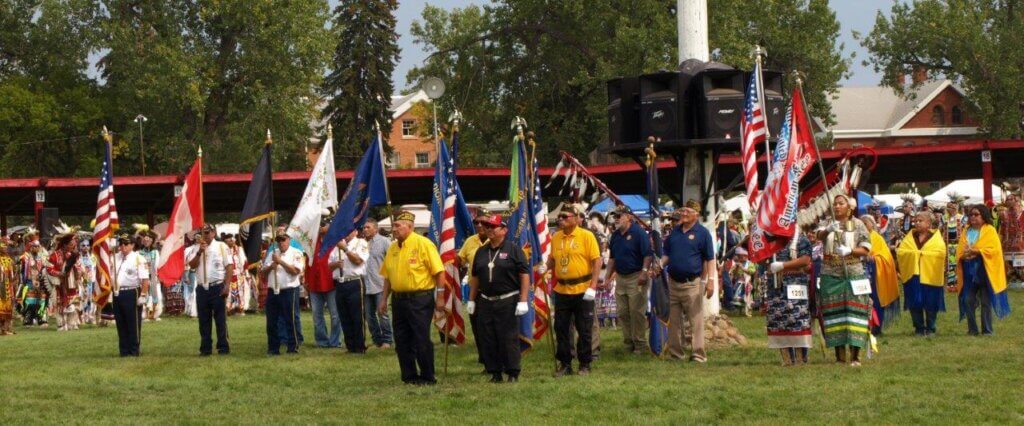
Traditionally the powwow is led by veterans. The United Tribes Technical College (UTTC) powwow in Bismarck is one of the largest powwows in the nation. Photo with permission from ND Tourism.
“Enhancing Tribal Tourism while Preserving our Tribal Traditions & Sharing our Own Stories”
[This report on Tourism and Powwows is excerpted from publications developed by the 5 North Dakota Native Tourism Alliance tribes. With permission from ND Tourism.]
The native tribes of North Dakota are an essential part of the state’s history and we welcome you to explore reservations and experience Native American culture.
Learn about each tribe’s history, language and traditions by visiting attractions like reconstructed earth lodge villages or attend a powwow and celebrate the culture through song and dance.
There are approximately 30,000 Native Americans living in North Dakota.
Though individual tribes have distinct and different origins, histories and languages, Plains Indians are united by core beliefs and values that emanate from respect for the earth and an understanding of humankind’s relationship with nature.
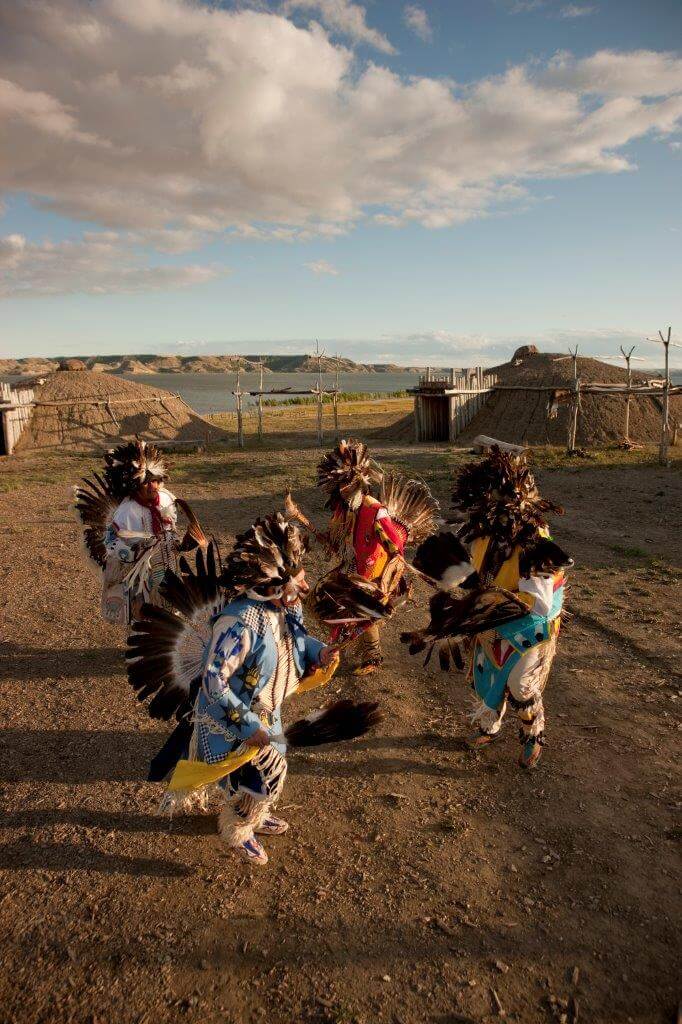
Men in their dancing regalia at a New Town Powwow near the Earth Lodges. Photo courtesy ND Tourism.
Ni-mi-win: The Powwow
Powwows (or “Ni-mi-win” in the Ojibwe language) are the Native American people’s way of meeting together, to join in dancing, singing, visiting, renewing old friendships and making new ones.
They are also one of the best ways to experience Native American culture, music and traditional crafts.
There are several different stories of how the powwow was started.
Some believe that the War dance Societies of the Ponca and other Southern Plains Tribes were the origin of the powwow.
Another belief is that when the Native American tribes were forced onto reservations the government also forced them to have dances for the public to come and see.
Before each dance, they were lead through the town in a parade, which is the beginning of the Grand Entry.
Powwow singers are very important figures in the powwow. Without them there would be no dancing. The songs are of many varieties, from religious to war to social.
As various tribes gathered together, they shared their songs, often changing the songs so singers of different tribes could join.
With these changes came the use of “vocables” to replace the words of the old songs. Thus, some songs today are sung in “vocables” with no words. Yet they still hold special meaning to those who know the song.
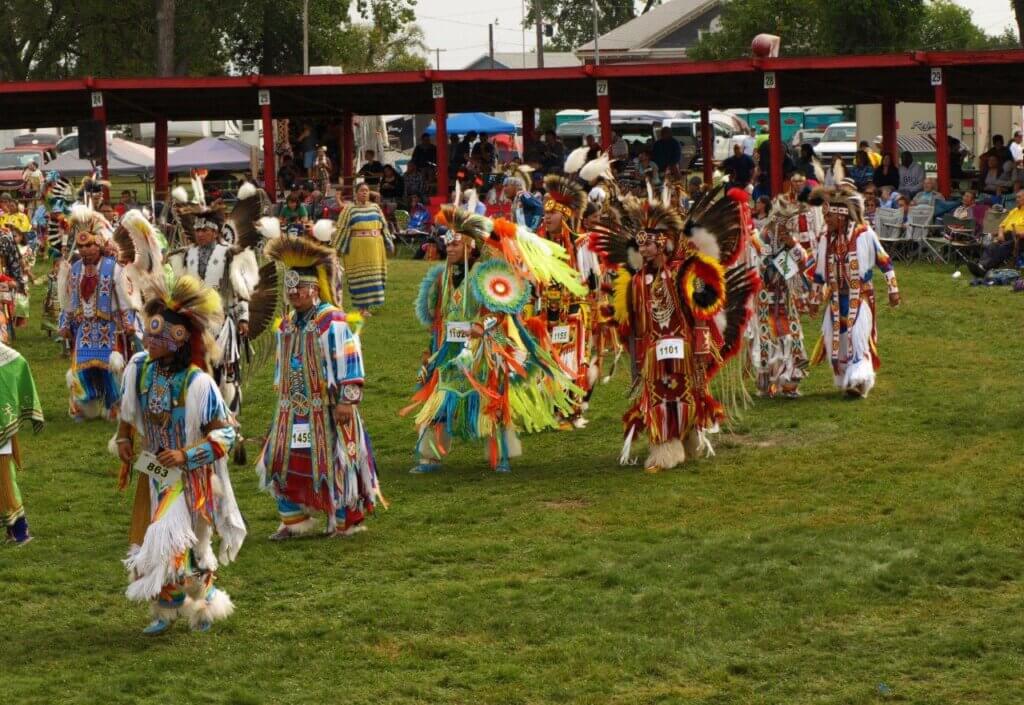
Men circle the powwow arena, in colorful regalia of their own choosing. It can be very expensive and special gifts may be a part of what they wear. Photo ND Tourism.
Many songs are still sung in Native American Languages either newly composed or revivals of old songs. These songs are reminders to the Indian people of their old ways and rich heritage.
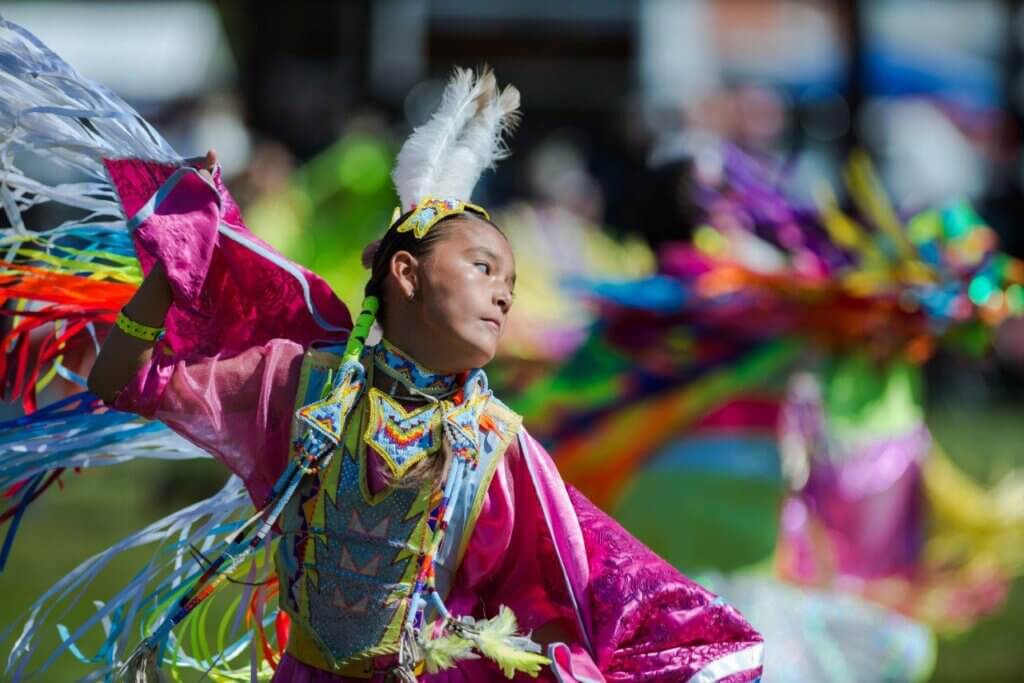
A young girl dances as if a bird, in bright colors and with feathers in her hair. Photo ND Tourism.
Boozhoo! Tawnshi! Legend of the Jingle Dress
The Jingle Dress Dance is commonly seen in competitive pow wows, performed by women and girls in First Nations and Native American communities.
The dance gets its name from the rows of metal cones—called “ziibaaska’iganan”—attached to their dresses, which make a distinctive sound as they dance.
The ritual has a rich history, and there are few sights as mesmerizing as watching and hearing the women perform the light, elegant dance style in their Jingle Dresses.
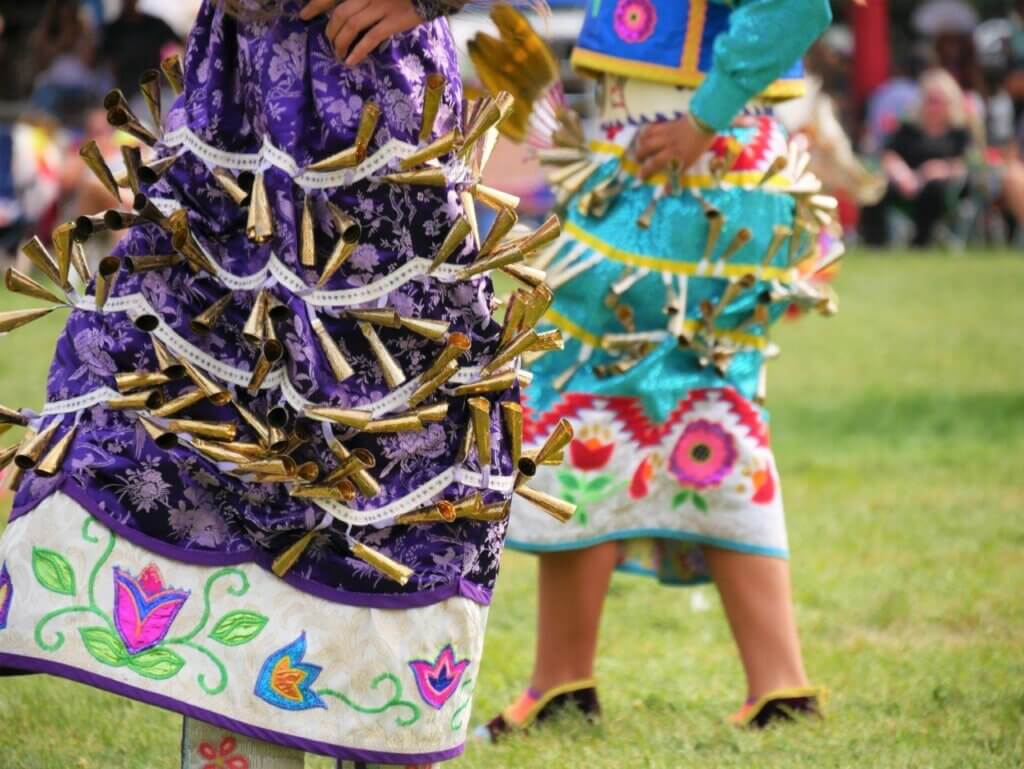
Metal cones attached to their dresses make a pleasing sound as women dance in the light, elegant style of their Jingle Dresses. ND Tourism.
North Dakota Native Tourism Alliance (NDNTA)
The North Dakota Native Tourism Alliance says it is the first in the nation to unite all the tribes of a state to work together on tourism. The new coalition will promote the culture and history of sovereign nations.
The vision of the North Dakota Native Tourism Alliance (NDNTA) is to enhance and promote Tribal Tourism as a means of economic development and growth for all ND Tribal Nations, while maintaining respect for sovereignty, tribal traditions and lands.
The mission of NDNTA is to protect, promote, preserve and educate the world about the culture, history and environment of our sovereign nations. NDNTA will promote and educate through sustainable tourism while developing economic opportunities for our people and nations.
North Dakota’s Native American tribes have a colorful history. A relatively new nonprofit intends to educate the world on their cultures and heritage.
“One of the main things is to promote our stories from our perspective to the world and being able to work with partners throughout the state to promote tourism and create jobs,” says Les Thomas, former Native Tourism Alliance board chair. “To enhance and promote Tribal Tourism as a means of economic development and growth for all North Dakota Tribal Nations, while maintaining respect for sovereignty, tribal traditions and lands.”
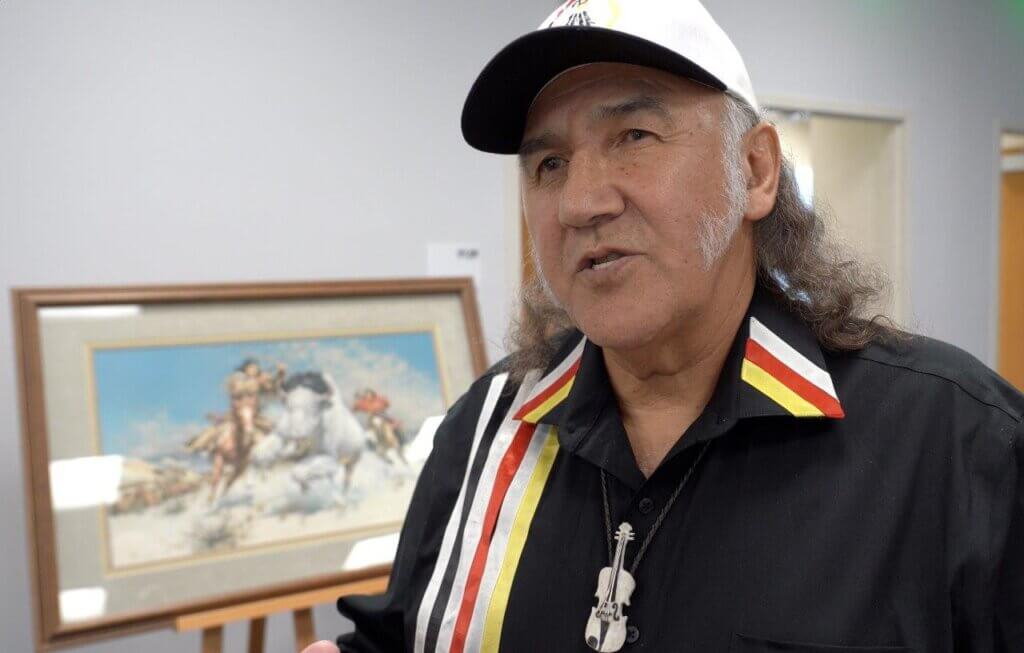
Les Thomas, former NDDNTA chair and now Vice-Chair, views the exhibit of Buffalo Paintings during the Bismarck State College Bison Symposium in June 2022. He is Chippewa from the Turtle Mountain Tourism Alliance in Belcourt. Photo ND Tourism, by Jim Kambeitz.
Five North Dakota Tribes
The NDNTA is a coalition representing the tourism interests of the 5 ND Tribal Nations: Mandan, Hidatsa and Arikara (MHA), Sisseton Wahpeton Oyate, Spirit Lake Nation, Standing Rock Sioux Tribe and the Turtle Mountain Band of Chippewa.
Mandan, Hidatsa and Arikara (MHA)
The Mandan, Hidatsa and Arikara Nation, also known as the Three Affiliated Tribes, is located on the Fort Berthold Indian Reservation in central North Dakota. The reservation consists of 988,000 acres, of which 457,837 acres are owned by Native Americans, either as individual allotments or communally by the tribe.
The Tribal headquarters is located 4 miles west of New Town, ND. Chairman Mark N. Fox and the MHA Nation Tribal Business Council invite you to visit the Fort Berthold Reservation and learn more about our government, culture and history.
Travel to where Lewis and Clark stayed with the Mandan, Hidatsa and Arikara Tribes! See what the explorers saw as you learn the history of MHA Nation, from their historic trade route to modern-day innovations.
Visit the Dakota people of the Spirit Lake Nation, the namesakes of two American states, and explore culturally significant sites like Fort Totten all while learning history from tribal elders such as the region’s military and boarding school.
The Spirit Lake Tribe consists of four (4) districts. Tribal members living in each district are as follows:
Mission District 692
Woodlake District 266
Fort Totten District 947
Crowhill District 164
For tourists; there is fishing on Spirit Lake in the summer months which you can continue until the end of winter. Also visit the Fort Totten State Historic Site located in Fort Totten and which the people of Spirit Lake call ‘The Square.’
Sullys Hill National Game Preserve near Fort Totten has a herd of North American Bison, prairie dog town, scenic outlooks and a Visitor Center.
Standing Rock Sioux Tribe
Home to the Hunkpapa, Ihanktonwan, Hunkpati and Sihasapa bands of the Dakota Lakota Oyate, the Standing Rock Sioux Tribe welcomes you in helping preserve our culture and identity by experiencing traditional storytelling, caring for buffalo and grazing our grasslands.
The Dakota people of Standing Rock include the Upper Yanktonai in their language called Ihanktonwana which translates “Little End Village” and Lower Yanktonai, called Hunkpatina in their language, “Campers at the Horn” or “End of the Camping Circle.” When the Middle Sioux moved onto the prairie they had contact with the semisedentary riverine tribes such as the Mandan, Hidatsa and Arikara.
Eventually the Yanktonai displaced these tribes and forced them upstream. However, periodically the Yanktonai engaged in trade with these tribes and eventually some bands adopted the earthlodge, bullboat and horticultural techniques of these people, though buffalo remained their primary food source.
Today Yanktonai people of Standing Rock live primarily in communities on the North Dakota portion of the reservation.
The Lakota, as the largest division of the Sioux, subdivided into the Ti Sakowin or Seven Tents and Lakota people of the Standing Rock Reservation included two of these subdivisions, the Hunkpapa which means “Campers at the Horn” in English and Sihasapa or “Blackfeet” (not to be confused with the Algonquian Blackfeet of Montana and Canada which are an entirely different group.)
The new culture revolved around the horse and buffalo. Today the Lakota at Standing Rock live predominantly in communities located on the South Dakota portion of the reservation.
Turtle Mountain Band of Chippewa
Travel back in time to the late 1800s while locals tell you how the Turtle Mountain Band of Chippewa Indians lived off the land. Learn the history and traditions which were influenced by 3 unique cultures: Anishinabe, Cree and Metis!
The Turtle Mountain Chippewa community is a vibrant multi-cultural community that includes traditions from the Ojibwe (Anishinaabe) people and the Metis/Cree people to create a culture that is both unique and beautifully colorful and vibrant.
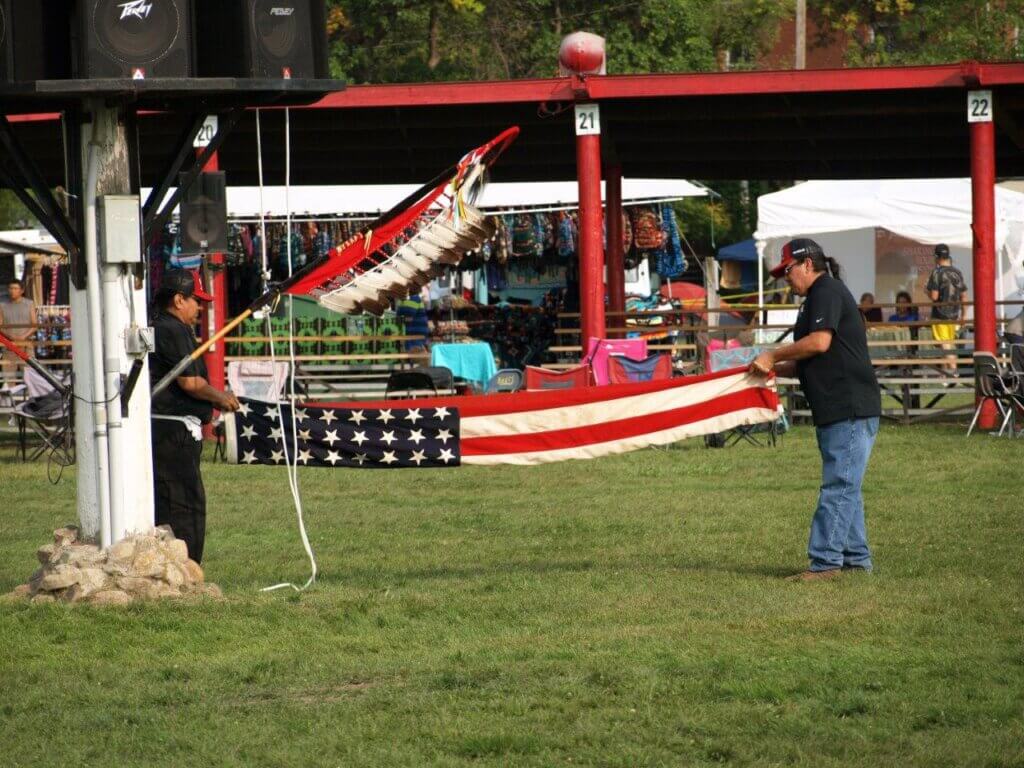
Respect for the flag and veterans is an important part of the powwow. Private 1st Class John Elk, code-talker is honored at UTTC powwow in Bismarck. ND Tourism.
Strength of the Alliance
Some of the tribes already had separate marketing departments. The alliance is helping unite them and partnering with the ND Department of Tourism.
Since re-establishing the NDNTA in May 2016, the regional Alliance has made significant strides with the support of its partners to establish their organizational structure, identify priority initiatives and gain visibility for indigenous tourism development. Main achievements include:
- The creation of the five-reservation NDNTA, operating as a nonprofit, with 10 voting directors and 8 non-voting advisory committee members
- Endorsement of NDNTA by 5 tribal councils and 5 tribal colleges
- Establishment of a Tourism Department within Spirit Lake Nation
- Vetted organizational bylaws and strategic plan for the NDNTA
- Identification of near-term experience development opportunities
- Increased awareness of North Dakota indigenous tourism through media coverage
The North Dakota Native Tourism Alliance is a nonprofit that works across the 5 tribal nations of North Dakota to implement a strategy for North Dakota Indian Country to build tourism capacity, advocate for infrastructure, conduct collective marketing and facilitate the development of cultural tourism enterprises.
We build partnerships with federal and state agencies, non-governmental organizations and educational institutions to prioritize tourism as an economic development strategy for our tribes. Through these efforts, we hope to educate North Dakota communities and visitors alike about our diverse histories and traditions through cultural tourism.
The Mission of the Turtle Mountain Chippewa Indian Heritage Center is to preserve, promote, and apprise the history, culture and language of the Tribe in order to promote wellness within the community and surrounding communities by educating the public—especially the youth—of the beautiful, health, holistic, diverse and living cultures here and how this can be used to benefit the lives of community members now and in the generations to come.
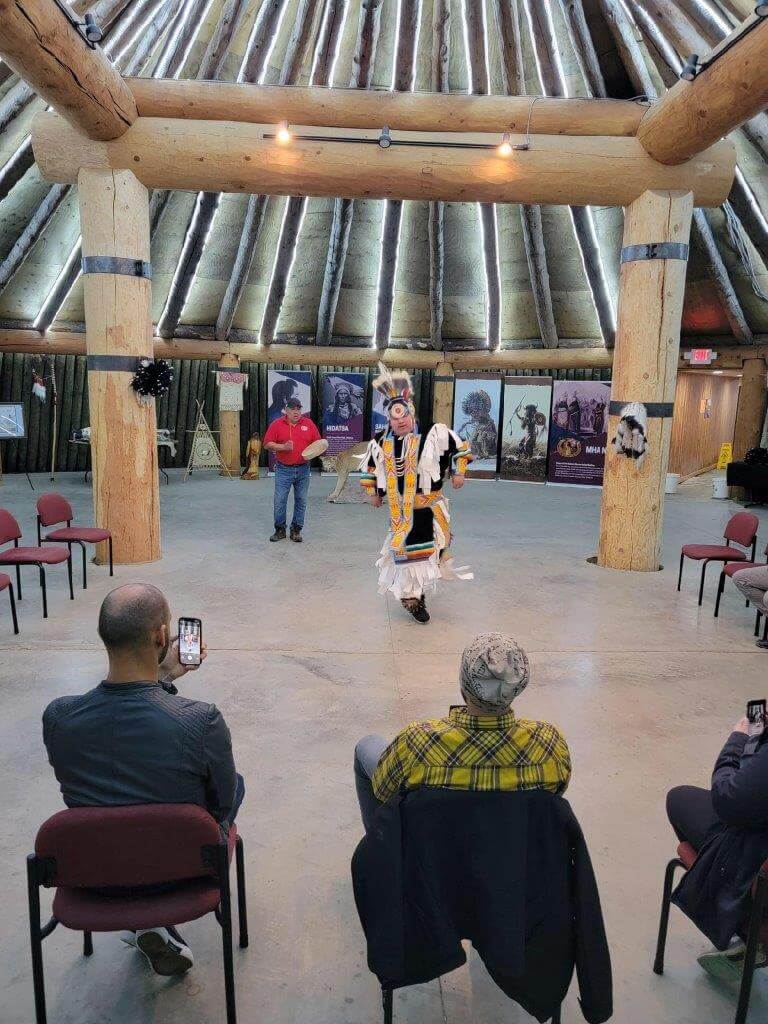
The purpose of the Heritage Center is to preserve written documents and artifacts of the Turtle Mountain Band of Chippewa. And to make historical materials available for use by the Turtle Mountain people and others who desire to learn more about the Tribe and its unique cultural heritage. ND Tourism.
Turtle Mountain Heritage Center
39SkyDancer Way NE; Belcourt ND 58316
701-244-5530
Chiiiippewaheritage19@hotmail.com
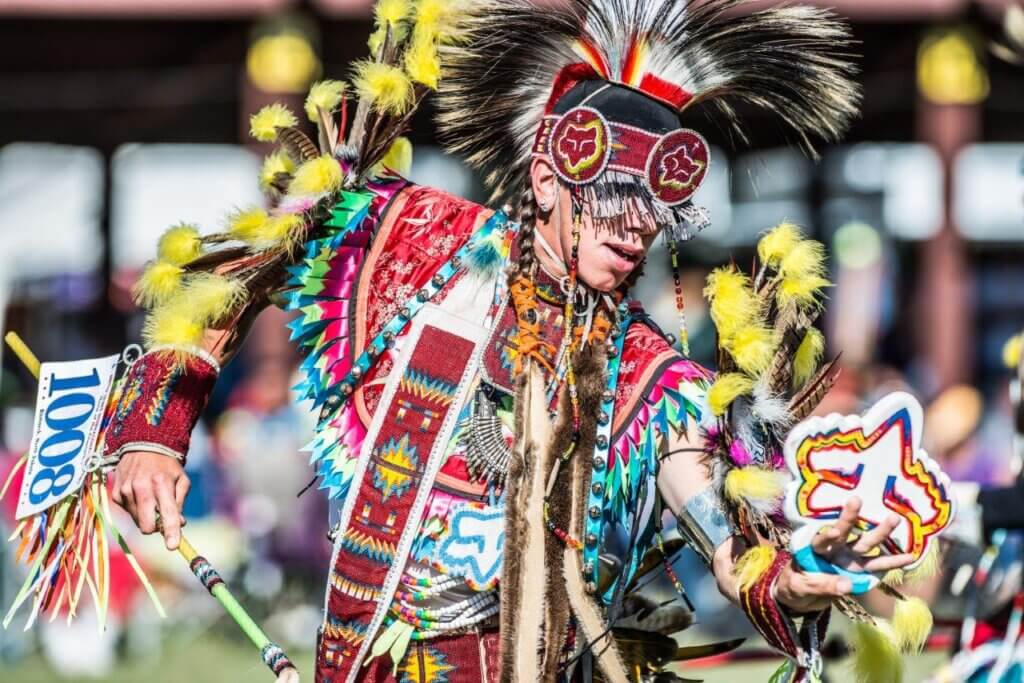
Junior Men’s Traditional Dancer competes at the United Tribes International Powwow in Bismarck. ND Tourism
“It’s an opportunity for each tribe to showcase what they have and tell their own story and bring the people off the highways and interstates,” said Darian Morsette, Mandan Hidatsa Arikara Tourism director.
One of the focuses for the group is showing the differences in the cultures and histories of the tribes.
“You want to make sure that the cultural sensitivity is there, the understanding is there and the knowledge, the questions can be answered. We want to make sure that the people are comfortable in coming into North Dakota and saying there’s Native Americans, where are they,” said Jason Morsette, Tourism Alliance.
The group was given $5,000 from each of the tribes to help get started and other grants and donations will help operate the venture.
They expect to market to some of the same areas the Department of Tourism targets, such as northern Europe.
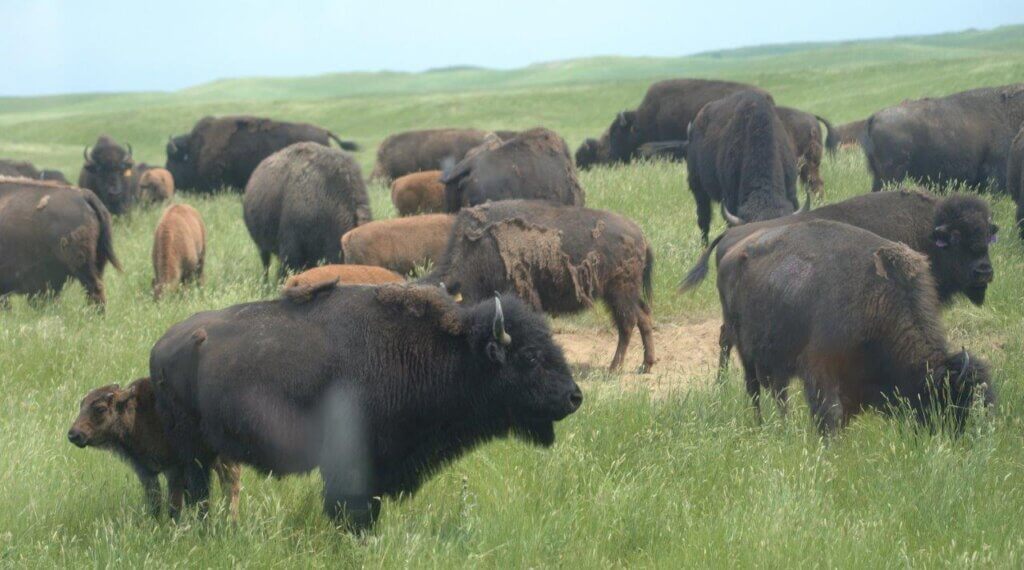
The tribes have their own buffalo herds. Photo ND Tourism by Jim Kambeitz.
Contact Information
Mandan, Hidatsa & Arikara Nation headquarters
404 Frontage Road New Town, ND 58763
(701) 627-4781
Sisseton Wahpeton Oyate Tribal office:
605-698-3911
webadmin@swo-nsn.gov
Spirit Lake Nation Tribal Office
PO Box 359, Fort Totten, ND 58335
Phone: 701-766-4221
Standing Rock Sioux Tribal Headquarters
1 Standing Rock Ave; Fort Yates, ND 58538
701-854-8500
info@standingrock.org
Turtle Mountain Band of Chippewa Tribal Headquarters
4180 Highway 281; Belcourt, ND 58316
701) 244-2400
selinaree2000@yahoo.com
Tribal HQ Front Desk
(701) 477-2600
info@tmbci.org

Francie M Berg
Author of the Buffalo Tales &Trails blog


